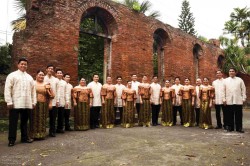The last two WholeNote columns I wrote examined some general aspects of choirs and the practice of choral singing, a topic that did not meet with unanimous approval. A friend who can be relied on never to mince words said something to the tune of, “Can’t you just tell us what concerts are going on? All this navel-gazing about the meaning of choral singing is kind of self-indulgent.”
My first thought was that this comment was completely unjust. But just to make sure that I had not overreacted to reasonable criticism, I resolved to sternly inspect my actions and motivations. Hewing to a strict schedule, I spent every evening of the following week sitting on the back deck, drinking wine or coffee depending on my whim, moodily watching the sunset, writing about my feelings in my journal and listening to my favourite music.
At the end of the week I was absolutely certain there could be no possible justification for characterizing as indulgent someone as rigorous, self-denying and ascetic as myself. So, the final question of this tripartite series, in this last WholeNote column before the fall season begins, is this: What gives a choir its particular identity?
Choirs can define themselves by the era and musical repertoire, making their specialty baroque or contemporary music. Most choirs sing diverse repertoire, and in a crowded choral market, it is challenging for choirs to find a way to stand out from the crowd in a manner that will attract an audience. As our knowledge of the performance practices of earlier eras has increased, the “one size fits all” choir that sings repertoire from five centuries is becoming a thing of the past.
Some choirs build themselves around music associated with a particular culture or region of the world. The greater Toronto area is likely the most diversely multicultural region of Canada, and the culture of the area is enriched by those who come and bring a bit of their home country’s musical practices with them. Such groups often strive to strike a balance between being exemplars and proponents of past traditions, and exploring the way in which new influences can challenge and reshape those traditions. The Heritage Singers were formed in 1977 by Grace Carter-Henry Lyons, who came to Canada from Jamaica. Its members hail from diverse parts of Africa and the Caribbean. They will be singing at Harbourfront on July 31.
 Cross-cultural influences can give a choir its identity, as in the case of the Philippine Madrigal Singers. Hailing from the Pacific Rim and based out of the University of the Philippines, they sing diverse music but have made their specialty the European renaissance madrigal and have been hugely successful in Europe. They perform in Toronto on July 13. Incidentally, they perform their concerts seated — my kind of choir.
Cross-cultural influences can give a choir its identity, as in the case of the Philippine Madrigal Singers. Hailing from the Pacific Rim and based out of the University of the Philippines, they sing diverse music but have made their specialty the European renaissance madrigal and have been hugely successful in Europe. They perform in Toronto on July 13. Incidentally, they perform their concerts seated — my kind of choir.
Often, groups are assembled for the express purpose of putting on a discreet performance. This summer is the first and, hopefully, inaugural year of the BlackCreek Summer Music Festival. Out of whole cloth, the festival has had to assemble a chorus for its concert performances. In the spring, the emails went out advertising work opportunities for choral singers. In this kind of situation, it is really the conductor that must pull together the group, quickly giving it an identity and aesthetic in a short rehearsal period. Listeners can judge whether or not this has been achieved at an August 27 performance of Beethoven’s Symphony No.9, with the great London Symphony Orchestra, conducted by Lorin Maazel.
Other festival performances this summer include the Arcady Singers performing Carl Orff’s Carmina Burana at the Boris Brott Festival on August 18, The Elmer Isler Singers at the Festival of the Sound (in Parry Sound) on August 6, and numerous concerts by the Elora Festival Singers during the Elora Festival, which runs July 8–31.
Choirs are often defined by (and sometimes named for) their conductor, such as the aforementioned Elmer Iseler Singers, and more recently, the relatively new Larkin Singers. One conductor whose presence is likely to be strongly felt in coming years is the new head of choral conducting at the University of Toronto, Hilary Apfelstadt. Originally from Nova Scotia, she has worked for years in the United States, at Ohio State University, and has guest conducted all over the world. She is this year’s conductor for the Ontario Youth Choir, an ever-changing group of young singers that assembles each summer to learn choral skills and give concerts. They will be performing on August 28 in Toronto.
Not so incidentally, Choirs Ontario, which coordinates the OYC program, celebrates its 40th anniversary with a gala reception and dinner after this concert. Choirs Ontario has been a staunch supporter of all the diverse choral groups of this region and it is a pleasure to congratulate them on 40 years of choral activism and advocacy.
Ben Stein is a Toronto tenor and theorbist. He can be contacted at choralscene@thewholenote.com.



